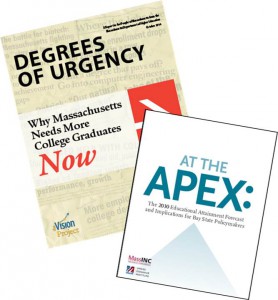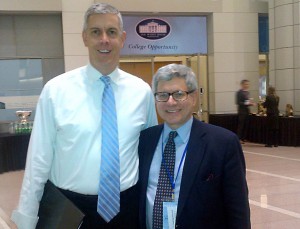‘We can’t afford waste of human resources’
December 12, 2014 | by David Driscoll and Gary Kaplan | commonwealthmagazine.com
Massachusetts prides itself on having the best public education system in the country, and our pride is justified. Thanks to the efforts of thousands of teachers, principals, superintendents, and other administrators – and the hard work of tens of thousands of students – we lead the country in every category of measurable student achievement. But the bright banner headlines obscure a subhead that should shock us into renewed action.
 Two recent reports, from Mass INC and the Massachusetts Department of Higher Education, sound an urgent warning: Massachusetts is not producing enough college graduates to support our economy’s need for skilled workers. Not only is the rate of increase flattening almost to zero; incredibly, the actual number of working-age college graduates is about to start going down just when the economy’s need for them is spiking up. State officials project a shortfall of 6,000 graduates per year from 2015 to 2025. Skilled workers are the fuel of economic growth, and our pipeline is drying up. The Massachusetts economy is running on empty.
Two recent reports, from Mass INC and the Massachusetts Department of Higher Education, sound an urgent warning: Massachusetts is not producing enough college graduates to support our economy’s need for skilled workers. Not only is the rate of increase flattening almost to zero; incredibly, the actual number of working-age college graduates is about to start going down just when the economy’s need for them is spiking up. State officials project a shortfall of 6,000 graduates per year from 2015 to 2025. Skilled workers are the fuel of economic growth, and our pipeline is drying up. The Massachusetts economy is running on empty.
How can this be? How can the best education system in the country be running low on college graduates? The studies give two reasons for this surprising shortfall: increasing industry demand for college graduates, and declining numbers of high school graduates to feed colleges. One trend line goes up; the other goes down. We can’t change those numbers. But there is another number we can change: the number of high school graduates we lose every year to remedial college courses.
This number is startling: 7,500 recent high school graduates, one-third of the high school graduates entering the three levels of public higher education. At the community college level, it’s over 60 percent – 6,000 students. These are students who want to go to college. Their aspirations, their attitudes, their motivation, and their commitment are aligned to higher education and productive careers. They want to go to school, but they cannot meet the academic standards of the institutions. Falling short on the required Accuplacer college placement tests, they are assigned to non-credit remedial (“developmental”) courses. Once in remediation, only 10 percent finish a community college degree.
We can’t afford this waste of human resources. The number of students we lose to remediation at the community colleges would fill the Department of Higher Education’s 6,000 gap. That’s right: closing the community college remediation gap would close the skilled worker gap.
And the remediation gap can be closed. High school students can be prepared for the Accuplacer college placement tests just as they are prepared for the SAT. JFYNetWorks integrates Accuplacer preparation into the high school curriculum, helping students pass Accuplacer tests and eliminate remedial courses while still in high school. We have helped students in dozens of high schools reduce remediation requirements by 1,600 courses, saving $857,000 in non-credit tuition and fees, money that can be invested instead in credit-earning courses that lead to a degree. No one would send a student to take the SAT without practice and preparation. Students deserve the same degree of preparation for the Accuplacer tests that determine their college course placement and their chances of graduation.
The Department of Elementary and Secondary Education has begun publishing the rates of assignment to remedial college courses for graduates of every high school in the Commonwealth on the Department website. School-by-school data can be accessed by clicking on DART and scrolling down to Success After High School.

JFYNetWorks was invited to the White House Summit on College Opportunity on December 4 to join the President’s campaign to increase rates of college entry and graduation. President and Mrs. Obama, Vice President Biden, and Secretaries Duncan and Castro urged secondary, higher education, and nonprofit leaders to strengthen their efforts to forge close links so that more students can make a smooth high school to college transition and arrive in college with the skills needed to succeed.
“Education is an investment in human capital,” President Obama said. “It’s both a moral and an economic issue. When we give young people the opportunity to chase their dreams, we’re investing in our collective future.”
Our pledge to the White House initiative is to expand our network of college readiness programs statewide, using a new state grant to kickstart the effort. We call upon Massachusetts school administrators, teachers, parents, students, and employers to join us in taking up the President’s challenge by closing the college readiness gap.
Twenty years ago, Massachusetts educators set themselves the task of bringing all students up to a basic high school skill level by using the measurement tool of MCAS. Now our young people face a higher hurdle, and our industry leaders are joining the President and First Lady to challenge our schools to mount a new effort. We can meet this new challenge. We can raise the level of student achievement to college readiness. We owe it to our young people. We owe it to the future of our Commonwealth.
David Driscoll is the former Massachusetts Commissioner of Education. Gary Kaplan is executive director of JFYNetWorks.





